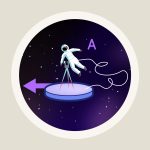Dictionary
curvature
For a two-dimensional surface: criterion that allows us to decide whether that surface is a plane, or part of a plane (i.e. a surface on which the usual rules of high school geometry apply), or not. Two possibilities to define the curvature of a plane are the following:
Sum of the angles of a triangle. In a plane, the sum of the three angles in a triangle formed by three straight lines is always 180 degrees. In a more general surface, the sum of the angles of a more general triangle formed by three straightest-possible lines (i.e. geodesics) can be larger or smaller than 180 degrees. The difference (the surplus or deficit), divided by the area of the triangle, is a measure for the curvature of that region of the surface.
Second possibility: the circumference of a circle. In the plane, that circumference is equal to 2 times pi times the circle’s radius. On a more general surface, it can be larger or smaller. The difference, divided by the third power of the radius, leads to the same measure for the curvature as the first definition.
Simple examples for curved surfaces are the surface of a sphere (positive curvature, that is to say: sum of the angles in a triangle larger than 180 degrees, circumference of a circle smaller than 2 times pi times radius) and that of a saddle (negative curvature, that is to say: sum of the angles in a triangle smaller than 180 degrees, circumference of a circle larger than 2 times pi times radius).
Curvature cannot only be defined for surfaces, but also for higher-dimensional, more general spaces or spacetimes. However, the generalized definition is substantially more complicated, and curvature is defined not by a single number, but by a set of numbers (that, together, form the “curvature tensor”). It’s basic meaning, however, is the same: it measures the space’s deviation from a flat space of the same dimension.
For physics, an important aspect of curvature is its connection with gravity, as described in Einstein’s general theory of relativity. Basic information about this can be found in the spotlight text Gravity: From weightlessness to curvature.









